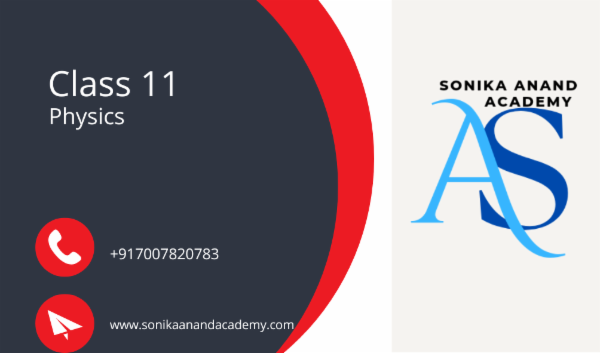
Class 11 Physics Master Course - Sonika Anand Academy
Sonika
15 modules
Bilingual
Access for 45 days
"Unleash the Power of Physics: Dive into the World of Forces, Motion, and Energy in Class 11!"
Overview
In the Physics Class 11 course, students will delve into the fundamental principles of physics as they embark on a journey to explore the fascinating world of matter, motion, energy, and more. This course is designed to cater to high school students who are at the cusp of transitioning from basic physics concepts to more advanced topics. Throughout the course, learners will cover a wide array of essential topics that serve as the building blocks of physics. These topics include mechanics, thermodynamics, waves, and optics, among others. By delving into these subjects, students will develop a robust foundation in physics that will serve as a solid platform for future academic pursuits in the field. One of the key highlights of the Physics Class 11 course is its emphasis on practical applications and real-world examples. Students will have the opportunity to witness how physics manifests in various phenomena that they encounter in their daily lives, thus fostering a deeper understanding of the subject. Through a mix of theoretical lessons, hands-on experiments, and problem-solving exercises, students will hone their critical thinking and analytical skills. Moreover, they will learn how to apply physics principles to solve complex problems and make sense of the world around them. By the end of the course, students can expect to have gained a comprehensive understanding of the core concepts in Physics Class 11. Whether they are aspiring scientists, engineers, or simply curious minds eager to unravel the mysteries of the universe, this course will equip them with the knowledge and skills needed to thrive in the field of physics.
Key Highlights
Introduction to basic concepts of physics
Understanding of Laws of Motion and Motion in a plane
Exploration of Kinematics and Gravitation
Study of Laws of Thermodynamics and Oscillations
Analysis of Work, Energy, and Power
Comprehension of Mechanical Properties of Solids and Fluids
Investigation of Waves and Physical Optics
Application of Physics in real-life scenarios
What you will learn
Introduction to Physics
Understand the basic concepts and principles of Physics in Class 11.
Mechanics and Motion
Learn about the laws of motion, forces, and kinematics to analyze motion in objects.
Thermodynamics and Heat Transfer
Explore the concepts of heat, temperature, and energy transfer in various systems.
Waves and Optics
Study the behavior of waves and delve into the optics phenomena like reflection and refraction.
Electricity and Magnetism
Gain insights into electrical circuits, electromagnetic induction, and magnetic fields.
Modules
Units Measurement and Dimensions
23 attachments • 4 hrs
Fundamental and Derived Quantities
Fundamental and Derived Quantities
Different Types of System of Units @sonikaanandacademy
Least Count @sonikaanandacademy
parallax method @sonikaanandacademy
Error Analysis
Significant Figures @sonikaanandacademy
Percentage Error@sonikaanandacademy
How to find errors in case of multiplication@ Sonika Anand Academy
Dimensional Analysis
Dimensions@sonikaanandacademy
How to check correctness of Equation @sonikaanandacademy
Derive the formula of equation using dimensional analysis@ sonikaanandacademy
how to derive formula using dimension analysis@sonikaanandacademy
How to check accuracy of formula@sonikaanandacademy
Notes Dimensions
5 pages
Dimensional Formula
6 pages
Test Series
NTA Mock test series physics @sonikaanandacademy
Revision in one Shot@sonikaanandacademy
Test Papers
Test Paper
2 pages
Test Paper 1
Motion in Straight Line
27 attachments • 7 hrs
Distance Displacement Average Speed
Conversion of units from Metre /second to kilometre/ hour @sonikaanandacademy
Average speed @sonikaanandacademy
Average speed Tricks @Sonika Anand Academy
How to find velocity distance and acceleration using differentiation and integration@sonikaanandacademy
Questions on Graph
Newton's Equation of motion ||graphical derivation@sonikaanandacademy
Basic Concept of Understanding of Graph @Sonika Anand Academy
NCERT solutions-Questions on graph@sonikaanandacademy
Numerical on graph @sonikaanandacademy
How to solve Graph in one shot
Motion Under Gravity
Lecture 1 @sonikaanand academy
Numerical on Motion under Gravity @sonikaanandacademy
Motion Under Gravity
Relative Motion
Questions on Relative Motion @Sonika Anand Academy
Relative Motion of Boat and Stream @sonikaanandacademy
Mock test series@Sonika Anand Academy
Class 1 Numerical on Distance and Displacement
Test series 2
Test Series 3
Test Paper
Test Paper - Motion in Straight Line
Motion in St line pdf
13 pages
Ncert Text Book Solutions
35 pages
Motion in Straight line
5 pages
Motion in a plane
36 attachments • 4 hrs
Vector
Typesof vector @Sonika Anand Academy
Types of Vectors Continued@Sonika Anand Academy
How to find the magnitude and unit vector @sonikaanandacademy
Unit vector @sonikaanandacademy
Questions on Unit vector and Magnitude of Vector @sonikaanandacademy
Addition and Subtraction of Vector @sonikaanandacademy
Resolution of vectors@sonikaanandacademy
Numerical on how to find position vectors@sonikaanandacademy
Numerical on speed and acceleration@sonikaanandacademy
Vector - how to find a speed velocity and acceleration when given in vector form@sonikaanandacademy
How to find dot product and cross product in one shot @sonikaanandacademy
Questions on Dot product and vector product@sonikaanandacademy
How to find unit vector Tangent @Sonika Anand Academy
Projectile Motion
Theory on projectile motion
Projectile motion
4 pages
Show path of projectile is parabola@Sonika Anand Academy
When an object falls under Gravity @Sonika Anand Academy
Numerical -- Projectile falls under Gravity @sonikaanandacademy
Projectile Motion -- Numerical Continued @sonikaanandacademy
Circular Motion
Lecture 1@sonikaanandacademy
centripetal force and centrifugal force @Sonika Anand Academy
Test Series
Extra
Numerical on graph @sonikaanandacademy
Circular Motion in one shot
Motion in straight line fall under gravity
Questions on Relative Motion @Sonika Anand Academy
Vector product
Numerical -- Projectile falls under Gravity @sonikaanandacademy
Projectile Motion -- Numerical Continued @sonikaanandacademy
Test Papers
Test Papers - Motion in plane
Ncert Solutions of Motion in Plane
39 pages
Laws of Motion
25 attachments • 4 hrs
Concept Base Lectures
Lecture 1 @Sonika Anand Academy
Lecture 2 @Sonika Anand Academy
Lecture 3@sonikaanandacademy
Lecture 4 @Sonika Anand Academy
Force Exerted by Spring @Sonika Anand Academy
Linear Momentum
Numericals on Linear Momentum @Sonika Anand Academy
Lecture 5 @Sonika Anand Academy
Lecture 6 @sonikaanandacademy
Recoil of Gun
Recoil of Gun and Numerical
Apparent Weight of Man in Lift
Apparent weight of man in lift @Sonika Anand Academy
Connected Bodies
Motion of connected bodies
Motion of Connected Bodies Continued
Motion of Connected Bodies Continued@Sonika Anand Academy
Friction
Friction ||Angle of Repose@Sonika Anand Academy
Friction Numericals @Sonika Anand Academy
Numericals on Friction Continued@Sonika Anand Academy
Test Paper
Test Paper - Laws of Motion
Ncert Solutions ofLawsof Motion
48 pages
Work Energy and Power
20 attachments • 2 hrs
Work
Lecture 1 numerical @sonikaanand academy
Lecture 2 numerical @sonikaanandacademy
Potential Energy
Theory Formula and questions with solutions
Kinetic Energy
Derivation of KE by calculus method
numerical of kinetic energy ||@sonikaanandacademy
Linear Momentum and KE
Work Energy Theorem
Work Energy Theorem
Power
Power and work Numericals@Sonika Anand Academy
Collisions
coefficient of restitution@Sonika Anand Academy
Test Series
work power and energy Numerical @Sonika Anand Academy
Test Papers
Test Paper - Work Power and Energy
Ncert Solutions of Work energy and Power
37 pages
System of Particles and Rotational Motion
39 attachments • 7 hrs
Ncert Text Book And Solution
Ncert Solutions of System of particles and Rotation System
53 pages
Video Lectures
Centre of Mass
Centre of mass Numerical @sonikaanandacademy
Centre of Mass - Numerical@Sonika Anand Academy
Numerical on centre of Mass @ Sonika Anand Academy
centre of mass 2@Sonika Anand Academy
Rotational Motion of a Rigid Body
Relation Between Angular Velocity and Angular Acceleration
Angular Velocity and Angular Acceleration @Sonika Anand Academy
Numerical @Sonika Anand Academy
Moment of Couple
Moment of Couple Numerical@sonikaanandacademy
Torque
Torque@Sonika Anand Academy
Numerical on Torque @Sonika Anand Academy
how to find torque when an automobile rotates@Sonika Anand Academy
Angular Momentum
Angular momentum@Sonika Anand Academy
find angular momentum when moment of inertia is given --Numerical @Sonika Anand Academy
Moment of Inertia
Moment of inertia@Sonika Anand Academy
Theorem of Moment of Inertia
Moment of Inertia for a Rod @Sonika Anand Academy
Moment of inertia of a rectangular Slab @Sonika Anand Academy
Moment of Inertia Rectangular Slab@Sonika Anand Academy
Moment of Inertia of Ring @Sonika Anand Academy
Trick to learn Moment of Inertia @Sonika Anand Academy
Total Energy in Rotational Motion
Rotational Energy in Inclined Plane
Class 11 physics ||System of particles and Rotational Motion ||Numericals @Sonika Anand Academy
Lecture 1 @Sonika Anand Academy
29
30 november
3 dec
5 dec
Test Papers
Model Test Paper For Rotational Motion
Gravitation
17 attachments • 1 hrs
Ncert Text Book and Solutions
Ncert solutions of Gravitation
27 pages
Video Lectures
Newtons Law of Gravitation
Newtons Law of Gravitation @sonikaanandacademy
Keplers Law
kepler Law@Sonika Anand Academy
Variation of g with height
Gravitational Energy
Gravitational Potential Energy
Escape and Orbital Velocity
Lecture 1 @Sonika Anand Academy
MCQ
MCQ 1 @Sonika Anand Academy
MCQ 2 @Sonika Anand Academy
Test Papers
Test Paper
Mechanical properties of Solids
8 attachments • 1 hrs
Modulus of Elasticity
Young Modulus Numerical
Stress@Sonika Anand Academy
Bulk Modulus , Shear Modulus
Mechanical Properties of Solids #Bulk Modulus Numerical
Numerical on Elasticity@Sonika Anand Academy
Test Papers
Test paper - Mechanical Properties of Solids
Mechanical Properties of Fluids
11 attachments • 2 mins
Fluid Pressure
Viscosity
Absolute pressure ,Atmospheric Pressure,Hydraulic Lift
Viscosity
Terminal Velocity and Numerical on Viscosity
Stream Line and Turbulent Flow ,Numerical on Reynold Number
Bernoulli 's Principle
Excess pressure on Soap Bubble
surface tension and velocity gradient
Test Papers
Test paper - Mechanical Properties of Fluids
Thermal Properties of Matter
6 attachments • 1 mins
Thermal conductivity
Thermal Expansion Linear Expansion@Sonika Anand Academy
Thermal capacity ,calorimetry
Newtons Law of cooling
Test paper
Test Paper
Thermodynamics
10 attachments • 16 mins
Zeroth Law of Thermodynamics
First Law of Thermodynamics @Sonika Anand Academy
work done during cyclic process
Mayer formula
Isothermal and adiabatic Process
Isothermal Process
Adiabatic Process
Second Law of Thermodynamics
Test Papers
Test Paper 1
Kinetic Theory
18 attachments • 2 hrs
Gas Laws
Boyle's law @ sonikaanandacademy
Kinetic theory of gases @Sonika Anand Academy
Charles law@Sonika Anand Academy
Kinetic theory of gases numerical @sonikaanandacademy
Gay Lussac Law@sonikaanandacademy
RMS velocity@sonikaanandacademy
Specific Heat Capacity
Thermal Capacity || specific heat numerical@sonikaanandacademy
Principal of calorimetry@Sonika Anand Academy
degree of freedom
Mock Test series of Heat and Thermodynamics@Sonika Anand Academy
ncert solutions
Ncert solutions
Degree of freedom
Ncert Solutions of Thermodynamics
Test Papers
Model Test Paper For Kinetic Theory of Gases
Oscillations -Simple Harmonic Motion
10 attachments • 21 mins
Video Solutions
what is periodic function
How to displacement ,velocity and acceleration of simple harmonic motion
Numerical on time period @Sonika Anand Academy
simple harmonic motion|| spring block system@Sonika Anand Academy
Numerical Based on Spring
Numerical on Spring
Numerical on spring continued
Test Papers
Model Test Paper For Oscillation
Waves
26 attachments • 3 hrs
What is Transverse and Longitudinal Wave
Transverse and Longitudinal Waves
Sound Waves
Transverse and Longitudinal Waves @Sonika Anand Academy
Transverse and longitudinal waves continued@sonikaanandacademy
How to find wavelength frequency and velocity of a wave
Graphical Representation of Simple Harmonic Wave
waves Numericals
Summary of Standing waves
Standing Waves
Standing Waves@Sonika Anand Academy
Numerical of Basic Concepts of SHM
Numerical of SHM
Node and Antinode -Wave@sonikaanandacademy
Interfearence of waves
part 1inerterfearence
Interference of light||wave optics@sonikaanandacademy
path difference|| Interference ||wave optics @sonikaanandacademy
Beats
Beats @Sonika Anand Academy
Doppler Effect
What is Doppler Effect
Doppler effect part 1 @Sonika Anand Academy
Doppler effect Continued @Sonika Anand Academy
Test papers
Test Paper Waves
HC Verma
6 attachments
Lesson 2
17 pages
Hc Verma solutions
6 pages
HC verma vector
7 pages
units and measurements
6 pages
HC Verma solutions Lesson 3
16 pages
question
5 pages
About the creator

Sonika
With years of teaching experience, she designed Sonika Anand Academy as a smart learning platform offering:
-
Structured video lectures
-
Concept notes and worksheets
-
Topic-wise MCQs & quizzes
-
Exam-oriented preparation
-
Guidance for both Boards and Competitive Exams
Rate this Course
Order ID:
This course is in your library
What are you waiting for? It’s time to start learning!

Wait up!
We see you’re already enrolled in this course till Access for 45 days. Do you still wish to enroll again?
